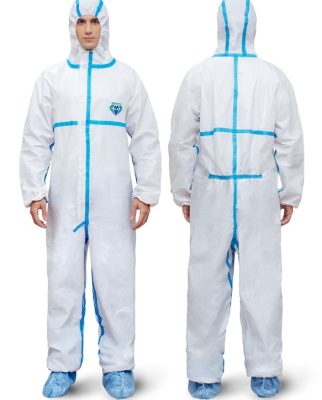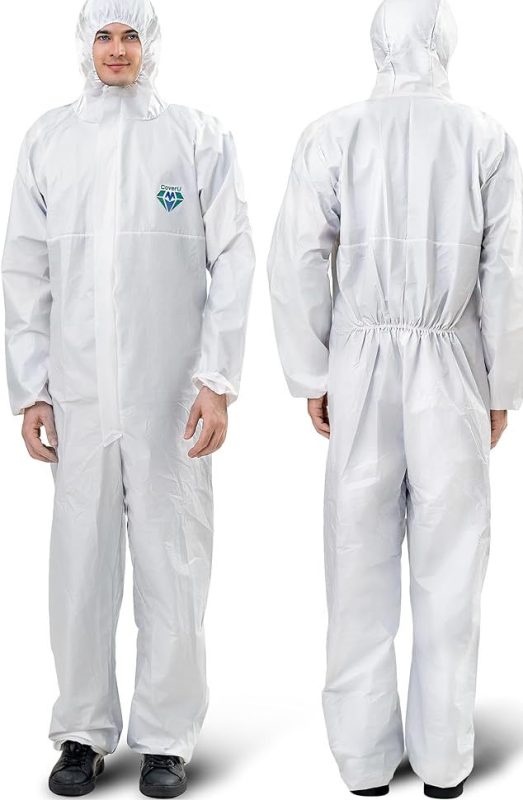Polypropylene coveralls are a type of protective clothing that are commonly used in various industries to protect workers from hazardous materials. Made from a lightweight and breathable synthetic material, polypropylene coveralls offer protection against non-hazardous materials like dust, dirt, and grime.
These coveralls are particularly useful in environments where liquid splashes and abrasion resistance are not a concern. They are also available in a variety of weights and colors to meet different needs. Polypropylene coveralls are widely used in the asbestos and abatement industries, as well as in other dirty industrial environments where exposure to chemicals is not a concern.
Overall, these garments are a cost-effective and practical solution for protecting workers from non-hazardous materials. They offer a lightweight and breathable alternative to traditional, more bulky coveralls, making them comfortable to wear for extended periods of time.

Understanding Polypropylene Coveralls
Polypropylene coveralls are a type of protective clothing that are designed to protect the wearer from various hazards such as dirt, grime, and non-hazardous liquid splashes. They are made from a synthetic material called polypropylene, which is a thermoplastic polymer that is known for its durability and lightweight.
They are commonly used in industries such as healthcare, food processing, and manufacturing, where workers are exposed to various hazards. They are also commonly used in cleanrooms, laboratories, and other environments where cleanliness and hygiene are of utmost importance
One of the advantages of polypropylene coveralls is their breathability. The fabric is designed to allow air to circulate freely, which helps to keep the wearer cool and comfortable. This is particularly important in environments where workers are required to wear protective clothing for extended periods.
Polypropylene coveralls are also disposable, which means they can be easily discarded after use. This helps to prevent the spread of contaminants and reduces the risk of cross-contamination.
In conclusion, polypropylene coveralls are an essential piece of protective clothing that are designed to provide workers with the necessary protection from various hazards. They are lightweight, durable, and breathable, making them ideal for use in a wide range of industries and environments.
Features of Polypropylene Coveralls
Polypropylene coveralls are a type of protective clothing that is widely used in various industries. They are made of a lightweight and durable fabric that is anti-static treated, making it ideal for non-hazardous personal and product protection. Here are some of the features of polypropylene coveralls:
Breathability
They are made of a cloth-like fabric that has exceptional breathability. This makes them comfortable to wear for extended periods, as they provide cool comfort all day long. The breathable fabric also helps to reduce the risk of heat stress, which is a common problem in hot and humid environments.
Protection
Polypropylene coveralls provide full-body protection against dirt, grime, and other contaminants. They are designed to be worn over regular clothing and provide an additional layer of protection. Polypropylene is also resistant to many chemicals, making it suitable for use in environments where there is a risk of exposure to hazardous substances.
Durability
Polypropylene coveralls are lightweight but durable. They are designed to withstand the rigors of everyday use and can be reused multiple times. The fabric is also tear-resistant, which helps to prevent rips and tears that can compromise the protective properties of the coveralls.
Cost-effective
Polypropylene coveralls are an affordable option for personal and product protection. They are less expensive than other types of protective clothing, such as Tyvek coveralls, but still provide adequate protection for non-hazardous environments. This makes them a popular choice for industries where cost is a significant factor.
Easy to Dispose of
Polypropylene coveralls are disposable, which makes them easy to dispose of after use. They can be safely disposed of in a garbage bag, which helps to prevent the spread of contaminants. Polypropylene is also recyclable, which makes it an environmentally friendly option for protective clothing.
Types of Polypropylene Coveralls
Polypropylene coveralls are a popular choice for those looking for a lightweight, breathable, and cost-effective option for protection against non-hazardous materials. There are different types of polypropylene coveralls available in the market, each designed to meet specific needs. This section will discuss some of the common types of polypropylene coveralls.
Basic Polypropylene Coveralls
Basic polypropylene coveralls are the most common type of polypropylene coveralls available in the market. They offer protection against dust, dirt, and grime and are suitable for use in environments where liquid splashes and abrasion resistance are not a concern. Basic polypropylene coveralls are lightweight and breathable, making them an ideal choice for extended wear.
SMS Polypropylene Coveralls
SMS polypropylene coveralls are made from a combination of spunbond and meltblown polypropylene fibers. They offer better protection against liquid splashes and are suitable for use in environments where there is a risk of exposure to hazardous materials. SMS polypropylene coveralls are also more durable than basic polypropylene coveralls and can withstand more wear and tear.
Microporous Polypropylene Coveralls
Microporous polypropylene coveralls are made from a combination of polypropylene and polyethylene. They offer the highest level of protection against liquid splashes and are suitable for use in environments where there is a high risk of exposure to hazardous materials. Microporous polypropylene coveralls are also more durable than basic and SMS polypropylene coveralls and can withstand the most wear and tear.
Colored Polypropylene Coveralls
Colored polypropylene coveralls are available in a range of colors, including blue, green, and white. They are suitable for use in environments where color-coding is necessary, such as in cleanrooms and laboratories. Colored polypropylene coveralls are also useful for identifying different departments or job roles in a workplace.
In conclusion, there are different types of polypropylene coveralls available in the market, each designed to meet specific needs. Basic polypropylene coveralls are suitable for use in environments where liquid splashes and abrasion resistance are not a concern. SMS polypropylene coveralls offer better protection against liquid splashes and are more durable than basic polypropylene coveralls.
Microporous polypropylene coveralls offer the highest level of protection against liquid splashes and are the most durable of all polypropylene coveralls. Colored polypropylene coveralls are useful for color-coding and identifying different departments or job roles in a workplace.
Usage and Applications
Polypropylene coveralls are versatile protective clothing that finds its application in various industries, including healthcare, manufacturing, and agriculture. These coveralls are designed to protect workers from hazardous materials and substances that may cause harm to their skin or clothes.
In healthcare, polypropylene coveralls are commonly used in hospitals, clinics, and laboratories to protect healthcare workers from infectious diseases and hazardous chemicals. These coveralls are effective in preventing the transmission of pathogens and protecting workers from exposure to bloodborne pathogens.
In the manufacturing industry, polypropylene coveralls are used in cleanrooms, food processing plants, and other manufacturing facilities to protect workers from dust, dirt, and other contaminants. These coveralls are also used in the automotive industry to protect workers from oil, grease, and other chemicals.
In agriculture, polypropylene coveralls are used by farmers and farm workers to protect themselves from pesticides, herbicides, and other chemicals. These coveralls are designed to prevent the penetration of harmful substances into the skin and clothes, thus reducing the risk of exposure to toxic chemicals.
Polypropylene coveralls are also used in other industries such as construction, mining, and oil and gas. These coveralls are designed to provide protection against a wide range of hazards, including chemicals, dust, and other particulate matter.
Overall, polypropylene coveralls are an essential protective clothing item that is used in various industries to protect workers from hazardous materials and substances. With their lightweight and breathable design, these coveralls provide excellent protection while ensuring comfort and ease of movement for workers.
Safety Standards
Polypropylene coveralls are designed to protect workers from non-hazardous materials like dust, dirt, and grime. However, it is important to note that these coveralls are not suitable for all work environments. It is crucial to adhere to safety standards to ensure the safety of workers.
The European Union has established safety standards for protective clothing, including coveralls. The EN 340 standard specifies general requirements for protective clothing, including design, ergonomics, and sizing. The EN 14605 standard specifies the requirements for protective clothing against liquid chemicals, including coveralls. This standard requires that the coveralls must have welded seams and must undergo penetration testing according to EN 369 to provide information on protection in relation to individual chemicals.
In the United States, the Occupational Safety and Health Administration (OSHA) has established safety standards for protective clothing, including coveralls. OSHA requires that employers assess the workplace for hazards and provide appropriate protective equipment, including coveralls. OSHA also requires that the coveralls must be properly fitted and maintained.
It is important to note that safety standards may vary depending on the industry and the specific work environment. Employers should consult with safety experts and regulatory agencies to ensure that they are following the appropriate safety standards for their workplace.
Maintenance and Care
Polypropylene coveralls are designed to protect the wearer from non-hazardous materials like dirt, dust, and grime. Proper maintenance and care of these coveralls can extend their lifespan and ensure they continue to provide adequate protection.
Washing and Drying
Polypropylene coveralls can be washed in a standard washing machine using warm water and a mild detergent. Avoid using bleach or fabric softeners as they can damage the fabric. After washing, hang the coveralls to air dry or use the dryer on low heat. Avoid high heat settings, as they can shrink or damage the fabric.
Storing
When not in use, polypropylene coveralls should be stored in a cool, dry place away from direct sunlight. Avoid folding or compressing the coveralls as this can cause creases that may not come out during washing.
Inspection
Before each use, inspect the coveralls for any signs of damage or wear. If any damage is found, the coveralls should be repaired or replaced. It is also important to inspect the coveralls after washing to ensure they are still in good condition.
Disposal
When the coveralls are no longer usable, they should be disposed of properly. Check with local regulations to determine the appropriate method of disposal. In general, polypropylene coveralls can be disposed of in regular household trash. However, if they have been contaminated with hazardous materials, they should be disposed of according to local regulations.
Selecting the Right Polypropylene Coveralls
When selecting polypropylene coveralls, it is important to consider the specific needs of the wearer and the type of work being performed. Here are some factors to keep in mind:
Material
Polypropylene coveralls are made from a lightweight, breathable material that is ideal for protecting against non-hazardous materials like dirt, dust, and grime. They are not suitable for use with hazardous materials or chemicals.
Size and Fit
It is important to choose a coverall that fits properly in order to provide adequate protection. If the coverall is too loose, it may allow particles to enter, while a coverall that is too tight may restrict movement and cause discomfort.
Style
Polypropylene coveralls come in a variety of styles, including basic, hooded, and elastic wrist and ankle. The style chosen should be appropriate for the task at hand and should provide adequate coverage.
Type of Closure
Polypropylene coveralls may feature either a zipper or snap closure. Zippers are more secure but may be more difficult to put on and take off. Snaps are easier to use but may not provide as secure a closure.
Color
Polypropylene coveralls come in a range of colors, including white, blue, and green. The color chosen may depend on the specific work environment. For example, white coveralls may be preferred in a laboratory setting, while blue or green coveralls may be more appropriate in a manufacturing or construction environment.
Overall, selecting the right polypropylene coveralls requires careful consideration of the specific needs of the wearer and the type of work being performed. By taking into account factors such as material, size and fit, style, type of closure, and color, it is possible to choose a coverall that provides adequate protection and comfort.
Environmental Impact
Polypropylene coveralls, like other personal protective equipment (PPE), have significant negative environmental impacts due to their production process, disposal methods, and contribution to waste. The widespread use of these body coveralls poses a significant threat to terrestrial and aquatic ecosystems, given their polluting nature and disposal frequency.
The use of disposable coveralls has significant negative environmental impacts due to their production process, disposal methods, and contribution to waste. They release toxic additives, greenhouse gases during production and contribute to landfills when disposed of improperly.
Despite growing environmental concerns with single-use plastic-based protective clothing, the recent COVID-19 pandemic has seen a significant increase in their use, which could result in a further surge of oceanic plastic pollution, adding to the mass of plastic waste that already threatens marine life.
Personal protective clothing is critical to shield users from highly infectious diseases including COVID‐19. Such clothing is predominantly single-use, made of plastic‐based synthetic fibers such as polypropylene and polyester, low cost and able to provide protection against pathogens. However, the environmental impacts of synthetic fiber are significant, including the release of microplastics into the environment, which can harm aquatic life and accumulate in the food chain.
It is necessary to promote the adoption of alternatives that increase the safe reusability of PPE clothing and reduce environmental and health hazards. A life cycle assessment of reusable and disposable cleanroom coveralls showed that the improvements over the disposable SMS PP coverall were 59% lower PE, 56% lower NRE, 57% lower GHG emissions, and 77% lower blue water consumption. In addition, the reusable system shows a 94-96% reduction in solid waste to the landfill from the cleanroom facility.
Market Trends
Polypropylene coveralls are gaining popularity in various industries due to their excellent properties such as high strength, durability, and resistance to chemicals and abrasion. The global polypropylene market is projected to grow at a CAGR of 5.2% from 2021 to 2028, which is expected to positively impact the demand for polypropylene coveralls.
The increasing demand for polypropylene coveralls is driven by the growing awareness of the importance of safety and hygiene in various industries. The COVID-19 pandemic has also contributed to the increased demand for these coveralls as they provide protection against the virus. The market is expected to continue to grow due to the increasing adoption of polypropylene coveralls in the healthcare, food, and chemical industries.
The United States is expected to retain the maximum share of the global disposable coveralls market by 2027, which includes polypropylene coveralls. The sub-segment of the oil and gas industry is also expected to boost the disposable coveralls market, which includes polypropylene coveralls.
The market trend towards sustainability and eco-friendliness is also expected to impact the polypropylene coveralls market. Manufacturers are focusing on developing eco-friendly polypropylene coveralls to meet the growing demand for sustainable products. The use of recycled polypropylene in the manufacturing of coveralls is also gaining popularity, which is expected to contribute to the growth of the market.
Overall, the polypropylene coveralls market is expected to grow due to the increasing demand for safety and hygiene in various industries, the impact of the COVID-19 pandemic, and the trend towards sustainability. Manufacturers are expected to focus on developing innovative and sustainable products to meet the growing demand for polypropylene coveralls.
Frequently Asked Questions
What are disposable coveralls made of?
Disposable coveralls are made of various materials such as polypropylene, SMS, microporous, and Tyvek. Polypropylene coveralls are made of a lightweight and breathable fabric that provides basic protection against dust and dirt.
What are the benefits of using disposable coveralls?
Disposable coveralls are an effective way to protect workers from hazardous materials, dust, and dirt. They are designed to be used once and then discarded, reducing the risk of contamination and the spread of germs. They are also lightweight, breathable, and comfortable to wear, making them ideal for extended use.
How do polypropylene coveralls compare to SMS coveralls?
Polypropylene coveralls are typically more cost-effective than SMS coveralls. While SMS coveralls provide a higher level of protection against hazardous materials, they are also more expensive. Polypropylene coveralls are lightweight and breathable, making them ideal for non-hazardous environments.
Where can I purchase bulk polypropylene coveralls?
Bulk polypropylene coveralls can be purchased from a variety of suppliers, including online retailers such as Amazon, Walmart, and Grainger. It is important to choose a reputable supplier that provides high-quality products and reliable customer service.
What is the purpose of using protective disposable clothing?
The purpose of using protective disposable clothing, such as coveralls, is to protect workers from hazardous materials, dust, and dirt. They are designed to be used once and then discarded, reducing the risk of contamination and the spread of germs.
What companies sell polypropylene coveralls ?
Several companies sell disposable coveralls on Amazon, including DuPont, Lakeland Industries, and International Enviroguard. It is important to read product reviews and choose a reputable supplier when purchasing protective clothing online.
You can purchase high-quality disposable coveralls at TM&DV 8688 COMPANY LIMITED. We provide lightweight, breathable protective clothing ideal for healthcare, manufacturing, and cleanroom environments. Order now for safety and convenience!

